SIMM 2015-2016
Spring 2016
SIMM - April 2016
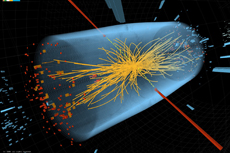
The Cosmic Frontier
James B. Dent, Department of Physics, UL Lafayette
3:30 - 5:00
Tuesday, 19 April 2016
Oliver Hall auditorium (room 112)
Abstract
I will review major puzzles in particle physics and cosmology from dark matter and gravitational waves to physics beyond the Standard Model of particle physics. I will discuss my (and my collaborators') research program and how it is aimed at helping to address some of these issues.
About the speaker
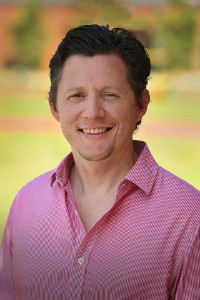 James Dent holds the Dr. and Mrs. Sammy W. Cosper / BoRSF Professorship in the department of physics at UL Lafayette where he also serves as the undergraduate program coordinator. James earned his BS at the University of Missouri - Rolla (Missouri University of Science and Technology) and his PhD, in the areas of in string theory related cosmology, from Texas A&M University. Before coming to UL Lafayette, he served as visiting assistant professor at Texas A&M (2005-2006), postdoctoral researcher at Vanderbilt University (2006-2009), and postdoctoral researcher at Arizona State University (2009-2012). His research covers a wide range of topics in theoretical cosmology and particle physics including dark matter, dark energy, and gravitation. James is author or coauthor of more than 45 peer-reviewed research publications.
James Dent holds the Dr. and Mrs. Sammy W. Cosper / BoRSF Professorship in the department of physics at UL Lafayette where he also serves as the undergraduate program coordinator. James earned his BS at the University of Missouri - Rolla (Missouri University of Science and Technology) and his PhD, in the areas of in string theory related cosmology, from Texas A&M University. Before coming to UL Lafayette, he served as visiting assistant professor at Texas A&M (2005-2006), postdoctoral researcher at Vanderbilt University (2006-2009), and postdoctoral researcher at Arizona State University (2009-2012). His research covers a wide range of topics in theoretical cosmology and particle physics including dark matter, dark energy, and gravitation. James is author or coauthor of more than 45 peer-reviewed research publications.
SIMM - March 2016
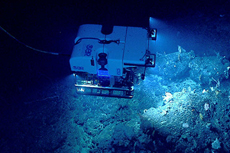
Studying Deep-Sea Coral in the New Era of Telepresence Technology
Scott C. France, Department of Biology, UL Lafayette
3:30 - 5:00
Tuesday, 15 March 2016
Oliver Hall auditorium (room 112)
Abstract
The deep sea – that part of the ocean beyond the continental shelf and deeper than approximately 200 m – was historically viewed by biologists as a lifeless desert, the so-called azoic zone, made so by crushing pressures, near-freezing temperatures and complete lack of sunlight. So it came as something of a surprise when the Challenger expedition dredged up animals from the deepest depths then sampled (5.5 km), and a greater surprise in the late 1960s when modifications to existing sampling devices revealed high species diversity in deep-sea muds. How were these species surviving, and what processes drove their diversification? Our ability to address these questions is hindered in part by the inaccessibility of the habitat, particularly the hard bottom areas of the seafloor (seamounts, ridges, canyons, etc.). Here the dynamic topography makes it difficult to drag standard sampling devices that are used over soft bottoms.
Scott is interested in the patterns and processes of species diversification in the deep sea. For the past 20 years his work has focused on deep-sea corals and the application of genetics methods to reveal diversity. These corals are most abundant and diverse in areas of steep slopes and micro-relief that show strong current flows and little sediment accumulation, the very locations that are most difficult to sample. However, developments in ROV technology, including more sophisticated manipulator arms and higher resolution video cameras, have allowed scientists to gain access to these remote, unexplored areas. Along with these developments is the emerging paradigm of Telepresence-Enabled Research, using real-time broadband satellite communications to connect at-sea operations and its discoveries live with scientists (and other audiences) ashore. Scott will present highlights from his deep-sea research and describe his experiences with Telepresence-Enabled Research.
About the speaker
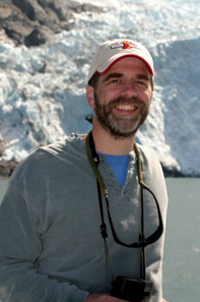 Scott France holds the Mr. Charles R. Godchaux/BORSF Professorship in Coastal Biodiversity Research Development and is Graduate Admissions Coordinator in Biology at UL Lafayette. Scott earned his B.S. in Biology at Concordia University (Canada) in 1986 after having started as a fine arts major, switching streams when he was captivated by the discovery of deep-sea hydrothermal vents. That new knowledge drove his desire to visit and explore the deep sea himself. He received his PhD in Oceanography from the Scripps Institution of Oceanography, University of California, San Diego, in 1992. He has held postdoctoral positions at the Woods Hole Oceanographic Institution, the University of New Hampshire, and Harvard University, and taught Evolution at Bowdoin College. He was on the faculty of the College of Charleston, from 1997-2003, before joining the Department of Biology at UL Lafayette in January 2004. In 2013 he was named the Ray P. Authement College of Sciences Outstanding Professor. Over his career, he has been on more than 20 research cruises and visited the deep-ocean floor off the Mariana Islands, Hawaii, Galapagos, California, Bahamas, and the western North Atlantic, and has analyzed genetic variation of deep-sea invertebrates from a variety of habitats, including hydrothermal vents, abyssal plains, seamounts, canyons, and trenches. Scott has published more than 40 peer-reviewed articles, and written several science blogs and magazine and encyclopedia entries. He has directed the theses and dissertations of 3 MS students and 4 PhD students and has served on more than 22 MS/26 PhD graduate student committees.
Scott France holds the Mr. Charles R. Godchaux/BORSF Professorship in Coastal Biodiversity Research Development and is Graduate Admissions Coordinator in Biology at UL Lafayette. Scott earned his B.S. in Biology at Concordia University (Canada) in 1986 after having started as a fine arts major, switching streams when he was captivated by the discovery of deep-sea hydrothermal vents. That new knowledge drove his desire to visit and explore the deep sea himself. He received his PhD in Oceanography from the Scripps Institution of Oceanography, University of California, San Diego, in 1992. He has held postdoctoral positions at the Woods Hole Oceanographic Institution, the University of New Hampshire, and Harvard University, and taught Evolution at Bowdoin College. He was on the faculty of the College of Charleston, from 1997-2003, before joining the Department of Biology at UL Lafayette in January 2004. In 2013 he was named the Ray P. Authement College of Sciences Outstanding Professor. Over his career, he has been on more than 20 research cruises and visited the deep-ocean floor off the Mariana Islands, Hawaii, Galapagos, California, Bahamas, and the western North Atlantic, and has analyzed genetic variation of deep-sea invertebrates from a variety of habitats, including hydrothermal vents, abyssal plains, seamounts, canyons, and trenches. Scott has published more than 40 peer-reviewed articles, and written several science blogs and magazine and encyclopedia entries. He has directed the theses and dissertations of 3 MS students and 4 PhD students and has served on more than 22 MS/26 PhD graduate student committees.
SIMM - February 2016
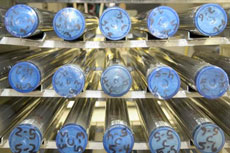
Chasing the Earth's Magnetic Field - With A Drillship
Carl Richter, School of Geosciences, UL Lafayette
3:30 - 5:00
Tuesday, 16 February 2016
Oliver Hall auditorium (room 112)
Abstract
Earth is exceptional among the terrestrial planets because it exhibits a strong magnetic field that has existed for several billion years. Much of our understanding of the behavior and history of this field is derived from paleomagnetic measurements of sedimentary sequences, which permit precise dating and the development of good records of both paleomagnetic directional and intensity variability. As the World's largest Earth Science operation, the International Ocean Discovery Program (IODP) and its predecessors DSDP, ODP, and IODP have conducted >150 coring expeditions comprised of 848 individual coring sites recovering 185 miles of sea floor deposits over the last thirty years. Many of those sites from all over the World have been drilled into deep-sea sediments with at least moderate (>10 cm/kyr) resolution records of paleomagnetic field variability and several sites recovered high- and super-high resolution records with sedimentation rates reaching 400 cm/kyr. IODP has routinely recovered pristine sequences of deep-sea sediments hundreds of meters in length from each site using the Advanced Piston Corer (APC). The geomagnetic field behavior determined from paleomagnetic studies of these sites has significantly improved our understanding of the history of the Earth's magnetic field and its relationship to paleointensity, excursions, and polarity reversals.
Carl participated in twelve two-months long IODP drilling expeditions to the Mediterranean Sea and the Pacific, Atlantic, and Southern Oceans during which he coordinated and participated in the recovery and scientific analysis of over 30 km of sediment core. Carl will present highlights and pictures from several IODP expeditions and illustrate how magnetic data are beginning to answer basic questions about the geomagnetic field behavior.
About the speaker
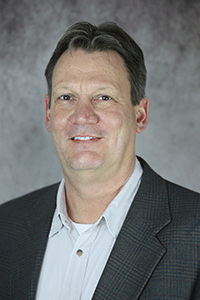 Carl Richter is Robert Pettit Endowed Professor and Program Coordinator of Geology at UL Lafayette. He received his Ph.D. from the University of Tuebingen (Germany) in 1990 and spent the following three years as a post-doctoral researcher at the University of Michigan investigating magnetic anisotropy. In 1993 he joined the world’s biggest Earth science research program, the Ocean Drilling Program at Texas A&M University, where he was involved in a wide variety of oceanographic drilling expeditions for nine years. He sailed the world’s oceans in an attempt to understand our Earth's past oceanographic and climatic history. In 2002 Carl accepted a position at UL Lafayette's Geology Department and has enjoyed university life as well as the local culture since. While his main expertise is in geomagnetic methods and their application to geology he is also interested in other geophysical research methods, such as gravity, resistivity, and seismic measurements. Carl has published over 160 articles, books, reports, and meeting abstracts. He has been a long-time member of the American Geophysical Union, the Geological Society of America, is past president of the Lafayette Geological Society and is currently president of the Southwest Louisiana Geophysical Society. He has directed over 20 MS students and is currently the chair of five thesis committees.
Carl Richter is Robert Pettit Endowed Professor and Program Coordinator of Geology at UL Lafayette. He received his Ph.D. from the University of Tuebingen (Germany) in 1990 and spent the following three years as a post-doctoral researcher at the University of Michigan investigating magnetic anisotropy. In 1993 he joined the world’s biggest Earth science research program, the Ocean Drilling Program at Texas A&M University, where he was involved in a wide variety of oceanographic drilling expeditions for nine years. He sailed the world’s oceans in an attempt to understand our Earth's past oceanographic and climatic history. In 2002 Carl accepted a position at UL Lafayette's Geology Department and has enjoyed university life as well as the local culture since. While his main expertise is in geomagnetic methods and their application to geology he is also interested in other geophysical research methods, such as gravity, resistivity, and seismic measurements. Carl has published over 160 articles, books, reports, and meeting abstracts. He has been a long-time member of the American Geophysical Union, the Geological Society of America, is past president of the Lafayette Geological Society and is currently president of the Southwest Louisiana Geophysical Society. He has directed over 20 MS students and is currently the chair of five thesis committees.
Fall 2015
SIMM - November 2015
Mathematics as an Interdisciplinary Tool in 2 Examples: (i) Dynamics of Mycobacterium marinum Infections, and (ii) Population Dynamics of an Invasive Species, Pomacea maculata
Karyn Sutton, Department of Mathematics, UL Lafayette
3:30 - 5:00
Tuesday, 24 November 2015
Oliver Hall auditorium (room 112)
Abstract
Mathematical modeling, analysis and related methodologies have long been powerful tools used in many disciplines to glean information from data sets and to further insight into underlying principles and mechanisms. Similarly, the need to develop new or extend existing mathematical frameworks and techniques frequently arise in response to real and pressing questions in applications. In recent years, mathematics has been applied extensively in the life sciences, furthering the advancement of both fields. I will highlight examples of the symbiotic nature of mathematics and the life sciences within the context of two current examples from my own research.
The first of these is the study of a TB-like bacteria, Mycobacterium marinum (Mm). Similar to human TB, there is a large pool of asymptomatic chronically infected individuals, a small fraction of individuals who quickly develop an aggressive infection, and a small fraction of individuals who will experience some activation of latent infection, and progress to a symptomatic and sometimes lethal state. The differences between these courses of progression is poorly understood and cannot be explained by medical/environmental factors. I will discuss recent progress and future plans in collaboration with Azmy Ackleh (Dean, College of Sciences) and Don Ennis (Biology) in the integration of novel biological and mathematical approaches to understand the mechanisms that result in highly variable disease outcomes.
The second example is the study of an invasive species, Pomacea maculata, or the island applesnail, in collaboration with Jacoby Carter (Wetlands and Aquatic Research Center). There have been several introductions along the Gulf Coast, and also in Louisiana. The potential for these snails to decimate or drastically alter the wetlands and/or local rice crops is real and uncertain. Most aspects of the applesnail's life cycle have not been quantified, making long-term predictions of its population size and impact difficult. I will present progress to date and outline future directions of experiments and corresponding mathematical modeling and analysis to develop a quantitative framework to address these pertinent questions.
Notably, there are similarities in the mathematical structures appropriate for both applications, speaking to the universal role and applicability of mathematics in science. Within both applications, I will highlight the novel methods and results established and outline the need for future work. The potential uses of the resulting framework and other relevant methodology will also briefly be discussed.
About the speaker
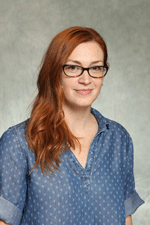 Karyn Sutton is an assistant professor in the Department of Mathematics at UL Lafayette. She earned her B. S. at University of Michigan - Ann Arbor in 2003, majoring in both mathematics and cell & molecular biology, and her M. A. (2005) and Ph. D. (2008) at Arizona State University in mathematics. She had a post doc at North Carolina State University (2008-2011) in the Center for Research in Scientific Computation and the Center for Quantitative Studies in Biomedicine. She holds an adjunct appointment at the Mathematical Computation and Modeling Sciences Center at Arizona State University and was a fellow of the Computational and Visualization Enterprise consortium here at UL Lafayette from 2012-2014. She joined the faculty at UL Lafayette in Jan 2012 and currently collaborates with local researchers in the Department of Biology and at the Wetlands and Aquatic Research Center. Her research focuses on the application of mathematics to solve real world problems arising in the life, social, and physical sciences, and heavily involves mathematical modeling, inverse problems, numerical analysis, and ordinary, partial, and delay differential equations.
Karyn Sutton is an assistant professor in the Department of Mathematics at UL Lafayette. She earned her B. S. at University of Michigan - Ann Arbor in 2003, majoring in both mathematics and cell & molecular biology, and her M. A. (2005) and Ph. D. (2008) at Arizona State University in mathematics. She had a post doc at North Carolina State University (2008-2011) in the Center for Research in Scientific Computation and the Center for Quantitative Studies in Biomedicine. She holds an adjunct appointment at the Mathematical Computation and Modeling Sciences Center at Arizona State University and was a fellow of the Computational and Visualization Enterprise consortium here at UL Lafayette from 2012-2014. She joined the faculty at UL Lafayette in Jan 2012 and currently collaborates with local researchers in the Department of Biology and at the Wetlands and Aquatic Research Center. Her research focuses on the application of mathematics to solve real world problems arising in the life, social, and physical sciences, and heavily involves mathematical modeling, inverse problems, numerical analysis, and ordinary, partial, and delay differential equations.
SIMM - October 2015
Carbon Dioxide Emission in the Atmosphere and its Fixation by Metal Complexes
Salah S. Massoud, Department of Chemistry, UL Lafayette
3:30 - 5:00
Tuesday, 27 October 2015
Oliver Hall auditorium (room 112)
Abstract
The chemical fixation may lead to certain devices that can eliminate the CO2 present in the air and hence controlling its concentration and reducing the environmental problems due to the greenhouse effect and global warming. This can be achieved by designing "inexpensive inorganic molecules" that can catalyze the atmospheric CO2 fixation. A number of simple N-donor ligands and multi-dentate Schiff bases containing two or more N-atoms, phenolic and alkoxy groups are used to synthesize a series of 3d (M(II) = Cu, Ni, Zn) and 4f lanthanides complexes (Ln(III)). The incorporation of Ln(III) ion into the skeleton of 3d complexes increases the affinity of the compounds for CO2 fixation into the Ln(III) pocket. The resulting bridged-carbonato complexes are not only interesting from the structural and geometrical points of views, but also may result in the discovery of interesting Single Molecular Magnets (SMM’s) which can be used to increase the memory elements of the computers. Recent developments concerning synthesis and structure characterization of different heteronuclear 3d-4f bridged-carbonato compounds, magnetic properties and their potential applications will be addressed.
About the speaker
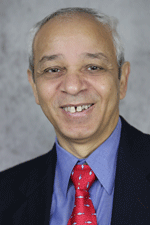 Salah Massoud is a professor of chemistry at UL Lafayette. Massoud received his BSc and MSc from Alexandria University, Egypt and PhD from Boston University. He had postdocs at Basel University (Switzerland), and University of Alberta (Edmonton, Canada). He has been visiting professor at Boston, Kuwait, Ohio and Houston Universities. He has published more than 140 papers in reputed and peer-reviewed journals, more than 60 presentations in National and International Meetings and he has been serving in the Editorial board committees in a number of journals (Magnetochemistry Journal, Journals of Advances in Chemistry, Modern Chemistry and Applications (JMCA), Dataset Papers in Materials Science).
Salah Massoud is a professor of chemistry at UL Lafayette. Massoud received his BSc and MSc from Alexandria University, Egypt and PhD from Boston University. He had postdocs at Basel University (Switzerland), and University of Alberta (Edmonton, Canada). He has been visiting professor at Boston, Kuwait, Ohio and Houston Universities. He has published more than 140 papers in reputed and peer-reviewed journals, more than 60 presentations in National and International Meetings and he has been serving in the Editorial board committees in a number of journals (Magnetochemistry Journal, Journals of Advances in Chemistry, Modern Chemistry and Applications (JMCA), Dataset Papers in Materials Science).
He joined the Chemistry Department at UL Lafayette in 2002 and since then he mentored more than 80 students in undergraduate research courses. His research interest is focused on bioinorganic chemistry and material sciences. In addition to his collaboration with most colleagues in the Chemistry Department at UL Lafayette, he has very active international collaboration with colleagues at Germany, Austria, Spain, Czech Republic and Japan.
SIMM - September 2015
The Chemist and the Surgeon: A Tale of Two Cultures
Subrata Dasgupta, School of Computing and Informatics, UL Lafayette
3:30 - 5:00
Tuesday, 29 September 2015
Oliver Hall auditorium (room 112)
Abstract
Once upon a time in my family there were two brothers. One was a professor of chemistry, the other was a surgeon. And here was a puzzle that struck me when I was still in high school: why was it that, though both belonged to the world of science, I never thought of the surgeon-brother as a scientist in the sense I perceived the chemist-brother to be one? In this talk I’d like to explore this personal conundrum, which has occupied me for my entire adult life, especially in my capacity as, first, a metallurgist and then a computer scientist.
About the speaker
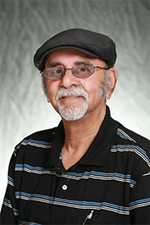 Subrata Dasgupta, Eminent Scholar Endowed Chair in Computer Science in the Center for Advanced Computer Studies, is a bi-cultural multidisciplinary scholar, scientist, and writer. A native of Calcutta, he was educated in England, India, and Canada.
Subrata Dasgupta, Eminent Scholar Endowed Chair in Computer Science in the Center for Advanced Computer Studies, is a bi-cultural multidisciplinary scholar, scientist, and writer. A native of Calcutta, he was educated in England, India, and Canada.
Dasgupta has been at UL Lafayette since 1982, was a founding faculty of the Center for Advanced Computer Studies in 1984, and was appointed to the Eminent Scholar Chair in 1993. He has also taught at Ohio State University, the University of Alberta and the University of Manchester Institute of Science and Technology. From 1999 to 2013 was the director of the Institute of Cognitive Science at UL Lafayette. From 1974 to 1991, Dasgupta's research spanned such branches of computer science as computer architecture, microprogramming, hardware description languages, program verification, and design theory. Since 1992, his work has focused on the cognitive and historical nature of creativity in the natural and artificial sciences, engineering and technology, art, literary scholarship, and cross-cultural milieux. In addition to numerous papers, essays and articles, he is the author of fourteen books.
One of his special interests is the nature of the creative mind spanning multiple cultures, especially the "Indo-Western mind". His work on the 19th century creative and intellectual movement in Bengal called the Bengal Renaissance addresses this mentality. His most recent book is It Began with Babbage: The Genesis of Computer Science (Oxford University Press 2014).
